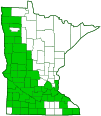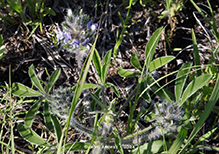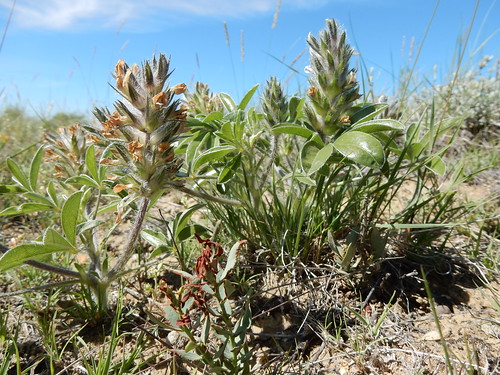prairie turnip
(Pediomelum esculentum)
Conservation • Description • Habitat • Ecology • Use • Distribution • Taxonomy
|
|
|||||||||||||
Description |
Prairie turnip is a 4″ to 16″ tall, erect, perennial forb that rises on 1 to 3 stems from a spindle-shaped or round, tuberous-thickened, deep, edible root. The stems are erect or ascending, often zigzagged, and much branched. They are densely covered with conspicuous, spreading hairs. The leaves are alternate and are palmately divided into 5 leaflets. They are on hairy leaf stalks, the larger leaves on stalks 1½″ to 4″ long. The leaflets are narrowly inversely egg-shaped or oblong to inversely lance-shaped and are folded along the midrib. They are ¾″ to 1½″ long and up to about ½″ to ¾″ wide when flattened. The upper surface is mostly hairless. The lower surface is densely covered with long, soft, silky, appressed, white hairs. The inflorescence is a dense, leafy, cone-shaped spike 1⅛″ to 3⅛″ long and about 1″ wide rising on a stout stalk from the upper leaf axils. The flowers are ⅝″ to ¾″ wide and pea-like, with 5 petals organized into a broad banner at the top, 2 narrow wings, and a keel in the center formed by two petals fused together at the tip. The petals are blue. The fruit is a densely hairy, egg-shaped pod with a beak obviously longer than the pod. It contains a single seed. |
Height |
4″ to 16″ |
Flower Color |
Blue |
Similar Species |
Habitat |
Dry. Undisturbed prairies. |
Ecology |
Flowering |
May to July |
Pests and Diseases |
|
Use |
|
Distribution |
||
|
Sources |
|
| 6/5/2024 | ||
Nativity |
||
Native |
||
Occurrence |
||
|
||
Taxonomy |
|
Kingdom |
|
Division |
Tracheophyta (Vascular Plants) |
Subdivision |
Spermatophytina (Seed Plants) |
Class |
|
Order |
Fabales (Legumes, Milkworts, and Allies) |
Family |
Fabaceae (Legumes) |
Subfamily |
Faboideae |
Tribe |
Psoraleeae (fountainbushes and allies) |
Genus |
Pediomelum (breadroots and scurfpeas) |
Subordinate Taxa |
|
|
|
Synonyms |
|
Lotodes esculentum Psoralea brachiata Psoralea esculenta |
|
Common Names |
|
breadroot breadroot scurfpea breadroot scurf-pea Indian breadroot Indian turnip large Indian breadroot prairie apple prairie potato prairie turnip prairie-turnip shaggy prairie-turnip |
|
Glossary
Axil
The upper angle where the leaf stalk meets the stem.
Palmate
Similar to a hand. Having more than three lobes or leaflets that radiate from a single point at the base of the leaf.
Rhizome
A horizontal, usually underground stem. It serves as a reproductive structure, producing roots below and shoots above at the nodes.
Visitor Photos |
||
Share your photo of this plant. |
||
This button not working for you? |
||
Dan W. Andree |
||
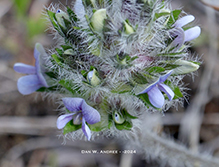 |
||
MinnesotaSeasons.com Photos |
||
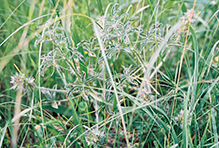 |
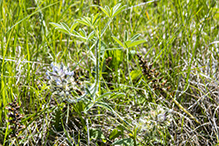 |
|
Plant |
||
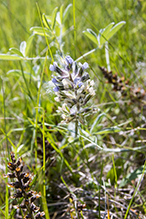 |
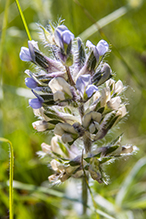 |
|
Inflorescence |
||
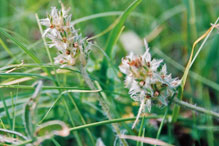 |
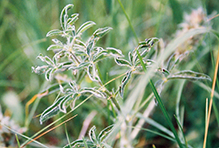 |
|
Inflorescence |
Leaves |

Slideshows |

Visitor Videos |
||
Share your video of this plant. |
||
This button not working for you? |
||
|
Other Videos |
||
Man vs. Wild - Yum! Prairie Turnip! |
About
Uploaded on Oct 21, 2008 Check out Bear's Ten SCARY SURVIVAL moments: http://dsc.discovery.com/videos/man-vs-wild-scary-survival-moments/?smid=YTDSC-YTD-PLP Bear Grylls demonstrates how to find and prepare this Native American survival food. |
Wild Foods: Prairie Turnip |
About
Published on Jun 19, 2014 Foraging for wild foods in the Great Plains. The Prairie Turnip or psoralea esculenta is a great food that was very important to the Native American tribes in the area |

Visitor Sightings |
||
Report a sighting of this plant. |
||
This button not working for you? |
||
Dan W. Andree |
Location: SNA in Norman Co. Mn. |
 |
MinnesotaSeasons.com Sightings |
||

|
Created: Last Updated: © MinnesotaSeasons.com. All rights reserved. |
